| |
Famous Barbarian Names
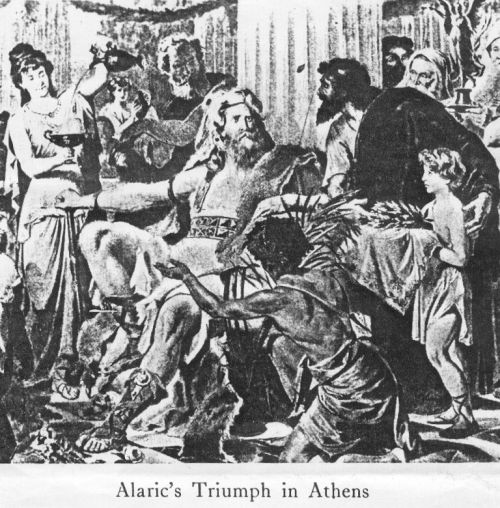
Alaric
One of the most famous barbarians, Alaric the Goth
(allegedly born on the coast of the Black Sea, at the mouth of the
Danube River on the isle of Peuce, on December 18, 371 C.E.), was the
first barbarian to successfully capture the city Rome in 410 C.E.
Although his troops spared most of the residents and the architecture
(Alaric was a known lover of beauty and literature) they pretty well
looted the place. Interestingly enough, a vision of his some 15
years before had predicted that he would successfully capture Rome.
After the capture, he traveled south with the intention of crossing over
into Africa, but was hindered by the storms along the Mediterranean
coast. Allegedly he took ill suddenly and died during this
expedition, and is supposedly buried near the river Busento.
However, legends and some historical evidence also claims that he
"faked" his death to save his people from capture from the
Romans and Vandals, and went "underground" so to speak, where
he continued to "rule" the later Visigothic kingdoms for
several decades, dying of old age finally in the year 470 C.E. (he
would have been 98 years old!). His descendants, the Visigoths, migrated
to the Iberian peninsula, and eventually became the Spaniards; an
indication of their heritage lies in the fair hair and blue eyes of the
Northern Spaniards. See also Stilicho below.
Attila (Atli)
One of the most feared and notorious barbarians of all
time, Attila, was not a Germanic or Celtic barbarian, but Hunnish.
Believed to be of distant Mongol stock, he ravaged much of the European
continent during the 5th century C.E. Apparently Attila was as
great a menace to the Teutonic tribespeople as he was to the Romans; he
and his forces were finally defeated by both Germans and Romans working
together (!) in 451 C.E. Attila supposedly died soon after.
The rumors of his cannibalistic practices are not unfounded; he is
supposed to have eaten two of his sons, even. He actually does
make a cameo appearance in the Volsung saga, as Gutrune's second husband
after Sigurd's death.
An excellent Attila site: Diether Etzel's Attila
the Hun and Barbarians page. This site also has some great
information on the Swabian barbarians.
There is also a discorse on Priscus
at the Court of Attila.
Boadicea (Boudicca)
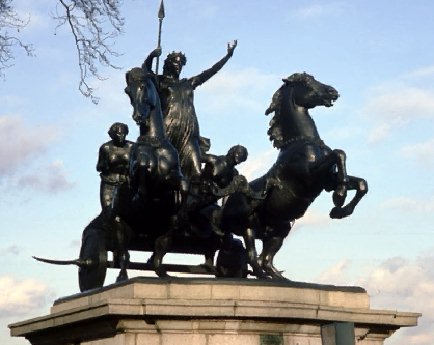
Not all of the famous barbarians were male. The
warrior queen of the Celts, Boadicea,
who reigned the tuath Iceni in what is now England during the 1st
century C.E., was one such female barbarian. In 61 C.E., she
led a revolt against the Roman invaion of Britain in retaliation for the
rape of her daughters by the Roman soldiers (under order from their
superiors.) Her army of Celts was victorious at first and
pushed the Romans back to London, which Boadicea and her forces sacked
and burned to the ground, killing almost all of the Roman citizens
therein. Her luck held until the battle of Mancetter, where
she and her army was defeated by the Roman general Suetonius Paulinus.
She allegedly died by taking poison administered by one of her faithful
druids, rather than suffer the ignominy of capture by her hated enemies.
Other Boadicea Links: Boudica,
Queen of the Iceni
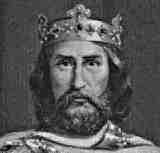 The grandson of Charles Martel (see below), Charles I
of France (April 2, 742-814 C.E.), the last of the Frankish Barbarian
kings, conquered much of Continental Europe, including the areas of
France, Germany, Poland, Austria, Hungary, some of the Balkan states,
and parts of Italy. He was crowned Holy Roman Emperor in 800 C.E.
by Pope Leo III, and was supposedly surprised at the Coronation; Pope
Leo having devised it on the sly. He never learned to read or
write, although was very learned by listening to visiting scholars and
monks read to him from the ancient works. Although the Carolingian
dynasty lasted only one generation after Charlemagne, the Empire lasted
1,118 years until the year 1918 C.E., when the last Holy Roman
(Hapsburg) Emperor, Karl, was defeated at the end of World War I.
Among other cultural reforms, Charlemagne was the first to establish the
idea of the Divine Right of succession, in which the King was considered
to be an avatar of the Christian God, as was his heir apparent.
Most of the constitutional traditions of continental European kingdoms
were derived from the reign of Charlemagne. The grandson of Charles Martel (see below), Charles I
of France (April 2, 742-814 C.E.), the last of the Frankish Barbarian
kings, conquered much of Continental Europe, including the areas of
France, Germany, Poland, Austria, Hungary, some of the Balkan states,
and parts of Italy. He was crowned Holy Roman Emperor in 800 C.E.
by Pope Leo III, and was supposedly surprised at the Coronation; Pope
Leo having devised it on the sly. He never learned to read or
write, although was very learned by listening to visiting scholars and
monks read to him from the ancient works. Although the Carolingian
dynasty lasted only one generation after Charlemagne, the Empire lasted
1,118 years until the year 1918 C.E., when the last Holy Roman
(Hapsburg) Emperor, Karl, was defeated at the end of World War I.
Among other cultural reforms, Charlemagne was the first to establish the
idea of the Divine Right of succession, in which the King was considered
to be an avatar of the Christian God, as was his heir apparent.
Most of the constitutional traditions of continental European kingdoms
were derived from the reign of Charlemagne.
Charles Martel
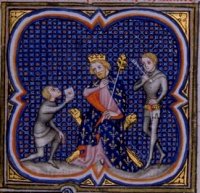 A Frankish barbarian of the eastern Frankish kingdom
of Austrasia, Charles Martel (688 - 741 C.E.) was most famous for the
Battle of Tours (732 C.E.), near Poitiers, in which he successfully
defeated the Saracen Moors in their invasion of France, thus preserving
Christian Europe from the encroachment of Islam. He held the title
of Mayor of the Palace of Austrasia, but in actuality wielded the power
of a king. His byname, "Martel," meant
"hammer" and was used to describe the way he indefatigably
drove back the Moorish invasion. A Frankish barbarian of the eastern Frankish kingdom
of Austrasia, Charles Martel (688 - 741 C.E.) was most famous for the
Battle of Tours (732 C.E.), near Poitiers, in which he successfully
defeated the Saracen Moors in their invasion of France, thus preserving
Christian Europe from the encroachment of Islam. He held the title
of Mayor of the Palace of Austrasia, but in actuality wielded the power
of a king. His byname, "Martel," meant
"hammer" and was used to describe the way he indefatigably
drove back the Moorish invasion.
Clovis
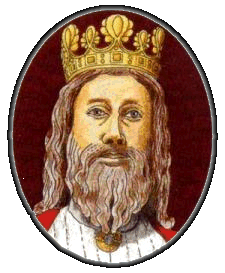 The Frankish barbarian Clovis (466-511 C.E.), son of
the drighten Childeric, started out as hot-headed and violent in his
nature. Vengeful to a fault, it is rumored that he slayed
a fellow soldier for breaking the famed Vase of Soissons a year
after the incident occurred (Clovis very much wanted the vase for
himself to present to the Bishop of Reims). His leadership prowess
was outstanding, however; using his abilities as a warlord and leader,
he established a kingdom stretching from the west bank of the Rhine
river to the Atlantic Ocean, uniting the Salian and Ripuarian Franks
into a single dominion. He married a Christian girl, Clothilde,
who eventually persuaded him to convert to Christianity in 496 C.E.
After his conversion, the bishops in his realm helped him to unite all
Christian people under one banner. He completely conquered the
Alamanni in 506 C.E., and defeated Alaric II, the last king of the
Visigoths, in Poitiers in 507 C.E. Clovis is known as the father
of the Frankish empire; and therefore, also of France. He
was the first ruler of the Merovingian Dynasty. After his death,
the Frankish kingdom was divided among his four sons. The Frankish barbarian Clovis (466-511 C.E.), son of
the drighten Childeric, started out as hot-headed and violent in his
nature. Vengeful to a fault, it is rumored that he slayed
a fellow soldier for breaking the famed Vase of Soissons a year
after the incident occurred (Clovis very much wanted the vase for
himself to present to the Bishop of Reims). His leadership prowess
was outstanding, however; using his abilities as a warlord and leader,
he established a kingdom stretching from the west bank of the Rhine
river to the Atlantic Ocean, uniting the Salian and Ripuarian Franks
into a single dominion. He married a Christian girl, Clothilde,
who eventually persuaded him to convert to Christianity in 496 C.E.
After his conversion, the bishops in his realm helped him to unite all
Christian people under one banner. He completely conquered the
Alamanni in 506 C.E., and defeated Alaric II, the last king of the
Visigoths, in Poitiers in 507 C.E. Clovis is known as the father
of the Frankish empire; and therefore, also of France. He
was the first ruler of the Merovingian Dynasty. After his death,
the Frankish kingdom was divided among his four sons.
Genseric (Gaiseric)
The Vandal king, Genseric, or Gaiseric
as he was also known, was one of the more notorious Barbarians, and
is probably largely the cause of the word "Vandal"
becoming a derogatory term in modern language. He was harsh and
cruel, both toward his subjects and towards the Romans, and was a rabid
Christian of a radical sect, violently opposed to any other expression
of Christianity or Paganism. Allegedly born on December 11, 390
C.E. in Gaul, Genseric was proclaimed king of the Vandals in 428,
deposing (and disposing of) his brother. In 439, he and his troops
seized the Roman city of Carthage on the North African coast, and
established a barbarian stronghold there, becoming an independent ruler
of North Africa in 442. He established treaties with the Romans,
which he later breached, and in 455, succeeded in sacking and looting
Rome itself. From 455 to his death (of old age!) in 477, the
Vandals, under Genseric's leadership, were the rulers of the
Mediterranean sea; providing one of the first examples of Barbarian
maritime warpower.
Many of Genseric's people remained in southern
Spain as well, along with the Visigoths (who actually ran many of the
Vandals out of Hispania and into North Africa). The region
was known as "Vandalus" until the invasion of the Islamic
Moors in 711 C.E., when they overran the region and renamed it "Al-Andalus."
Today, the Spanish region "Andalusia" bears the name and
ancient culture derived from both of these civilizations. (Many
thanks to Jes�s Balsinde for providing me with this information!)
Gundahar (Gunthur)
The Burgundian king Gundahar actually existed,
although his legendary account is more famous, thanks to Wagner.
He reigned in the court of Worms in what is now southwestern Germany,
along the Rhine. In the legends of the Volsung saga and the Nibelungenleid,
he is the brother of Gudrun, wife of Sigurd (Sigifried) the
Dragon-slayer; and husband of Brunhildde. Because of the treachery
in which he and his half-brother Hagan slayed Sigurd, he was doomed to
defeat at the hands of Attila in 436. Whether or not the legend is
fully true, King Gundahar did die at the hands of Attila and his forces,
along with 20,000 of his Burgundian warriors. His descendents
became part of the French nation; Bourgogne is one of the main divisions
of France to this day.
Hermann/Arminius
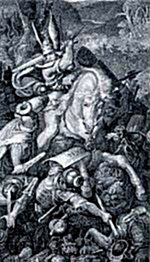 A drighten of the Cherusci, Hermann served under
General Varus during the Roman campaign to conquer Germany. Known
as Arminius to the Romans, he secretly plotted against them with his
tribesmen and led the Roman armies into a deadly trap in the Teutoberg
Forest in the year 9 C.E. His armies could not withstand the Roman
legion formation, but in the thick, dense Teutoberg Forest, the Romans
were forced to abandon their military formations and march single file,
in which guise they were easy prey for the furious Cheruscans. So many of the Roman soldiers were killed or captured
that Varus, in shame, committed suicide by falling on his sword.
Rome withdrew its forces back across the Rhine, and did not attempt any
further invasions of the Teutonic territories. A drighten of the Cherusci, Hermann served under
General Varus during the Roman campaign to conquer Germany. Known
as Arminius to the Romans, he secretly plotted against them with his
tribesmen and led the Roman armies into a deadly trap in the Teutoberg
Forest in the year 9 C.E. His armies could not withstand the Roman
legion formation, but in the thick, dense Teutoberg Forest, the Romans
were forced to abandon their military formations and march single file,
in which guise they were easy prey for the furious Cheruscans. So many of the Roman soldiers were killed or captured
that Varus, in shame, committed suicide by falling on his sword.
Rome withdrew its forces back across the Rhine, and did not attempt any
further invasions of the Teutonic territories.
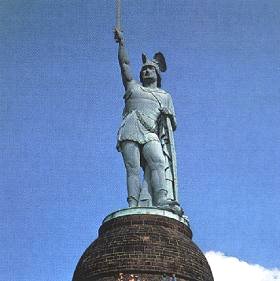
Statue of Hermann at the Battleground of
Teutoberg Vald
Odoacer
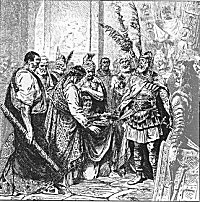 The Herulian Odoacer is credited with being the
barbarian who brought about the end of the Roman Empire. In 476
C.E., he forced the last of the Western emperors to abdicate.
Odoacer was a rash and arrogant fellow, though, with little concern for
others. It was no one's grief when he was slain by Theoderic in
489 C.E., although the manner of his death was fairly grisly; Theoderic
clove him from the shoulder down to the groin with his sword. The Herulian Odoacer is credited with being the
barbarian who brought about the end of the Roman Empire. In 476
C.E., he forced the last of the Western emperors to abdicate.
Odoacer was a rash and arrogant fellow, though, with little concern for
others. It was no one's grief when he was slain by Theoderic in
489 C.E., although the manner of his death was fairly grisly; Theoderic
clove him from the shoulder down to the groin with his sword.
Stilicho
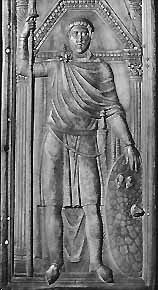 The Vandal Stilicho was the arch-enemy of Alaric the
Goth (see above.) The barbarian governor of the northern Roman
province, he and Alaric would cross forces 4 times between 392 and 402
C.E. No one understands why, in three different instances, that
Stilicho did not crush Alaric when he so easily could have.
Historians have speculated counter-treaties and
"back-stabbing" against Rome, but no concrete evidence was
ever found to support any of these theories. It seems that
Stilicho only wanted to keep Alaric at bay, not to destroy him.
Perhaps he hoped to team up with him at a later time when he felt that
Rome was weak. Stilicho's most heinous attack against Alaric came
on Good Friday, April 4, 402, when the Christian Goths were celebrating
their mass. The "Good Friday" massacre very nearly wiped
out the Goths, but through negotiations, Alaric was able to maintain his
forces. Again, Stilicho could have wiped him out, but didn't.
Stilicho was executed by the Romans on August 22, 408, for suspected
treason against Rome, along with thousands of barbarians who were living
peacefully in Rome. It was this last crime against the barbarian
people, it is believed, that gave Alaric his needed "in" for
being able to sack the city of Rome in 410. The Vandal Stilicho was the arch-enemy of Alaric the
Goth (see above.) The barbarian governor of the northern Roman
province, he and Alaric would cross forces 4 times between 392 and 402
C.E. No one understands why, in three different instances, that
Stilicho did not crush Alaric when he so easily could have.
Historians have speculated counter-treaties and
"back-stabbing" against Rome, but no concrete evidence was
ever found to support any of these theories. It seems that
Stilicho only wanted to keep Alaric at bay, not to destroy him.
Perhaps he hoped to team up with him at a later time when he felt that
Rome was weak. Stilicho's most heinous attack against Alaric came
on Good Friday, April 4, 402, when the Christian Goths were celebrating
their mass. The "Good Friday" massacre very nearly wiped
out the Goths, but through negotiations, Alaric was able to maintain his
forces. Again, Stilicho could have wiped him out, but didn't.
Stilicho was executed by the Romans on August 22, 408, for suspected
treason against Rome, along with thousands of barbarians who were living
peacefully in Rome. It was this last crime against the barbarian
people, it is believed, that gave Alaric his needed "in" for
being able to sack the city of Rome in 410.
Theoderic (Dietrich)
Theoderic
the Great, ruler of the Ostrogoths, was one of the last barbarians
at the fall of the Roman Empire. After Rome was utterly defeated,
he established treaties with all of the other Germanic tribes, and ruled
over sort of a "pax gothica" until his death during the
6th century C.E. After his death the Goths fell into squabbles and
inter-tribal battles, and were eventually defeated by the Byzantine
empire under Narses around 555 C.E. No more is heard about the
Goths after that time; supposedly they intermingled with the resident
cultures.
This site maintains a text of Theodoric's
(Theoderic's) Letters. They show him to be a man of wisdom and
fair dealing with others.
Vercingetorix
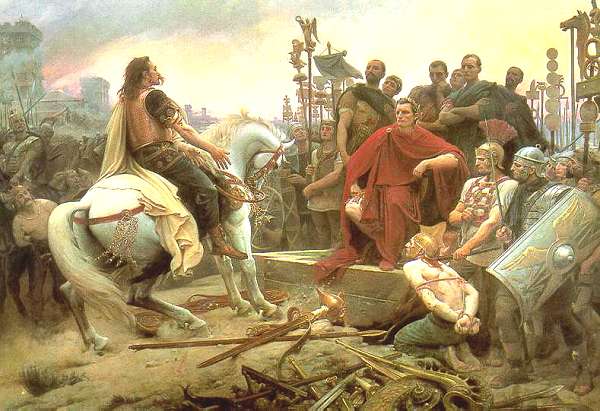
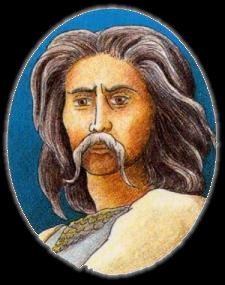 During Julius Caesar's occupation of Gaul (now much of
which is France) in the first century B.C.E., things were going fairly
smoothly for the Romans until an upstart Swabian Barbarian named
Ariovistus came moseying across the Rhine to see what was going on.
In fury, Julius Caesar chased him and his troops back across into
Germany (58 B.C.E) and proceeded to pursue the occupation of Gaul much
more aggressively than before. In anger, many of the Gallic
barbarian tribes, such as the Averni, rose up in revolt against the
harsh Roman treatment. A feisty young barbarian named
Vercingetorix (pronounced Ver-sin-JEH-toh-ricks) was adamant that Caesar
and the Romans would be driven out of Gaul. His people raised him
to kingship in 52 B.C.E. Under his leadership, the Gallic tribes were
very largely successful in quashing the Roman occupation, until the
fateful batttle of Alesia, where Vercingetorix and his troops were
forced to yield to Julius Caesar. Vercingetorix was captured as a
prisoner of war, taken back to Rome by the victorius Julius Caesar,
imprisoned there, and later executed by strangulation in 45 B.C.E.
Of course, Caesar himself was assassinated the next year by his own
people, so "what goes around, comes around." During Julius Caesar's occupation of Gaul (now much of
which is France) in the first century B.C.E., things were going fairly
smoothly for the Romans until an upstart Swabian Barbarian named
Ariovistus came moseying across the Rhine to see what was going on.
In fury, Julius Caesar chased him and his troops back across into
Germany (58 B.C.E) and proceeded to pursue the occupation of Gaul much
more aggressively than before. In anger, many of the Gallic
barbarian tribes, such as the Averni, rose up in revolt against the
harsh Roman treatment. A feisty young barbarian named
Vercingetorix (pronounced Ver-sin-JEH-toh-ricks) was adamant that Caesar
and the Romans would be driven out of Gaul. His people raised him
to kingship in 52 B.C.E. Under his leadership, the Gallic tribes were
very largely successful in quashing the Roman occupation, until the
fateful batttle of Alesia, where Vercingetorix and his troops were
forced to yield to Julius Caesar. Vercingetorix was captured as a
prisoner of war, taken back to Rome by the victorius Julius Caesar,
imprisoned there, and later executed by strangulation in 45 B.C.E.
Of course, Caesar himself was assassinated the next year by his own
people, so "what goes around, comes around."
Vortigern
 Vortigern
was a warlord in Britain during the 5th century C.E. By all
accounts, Vortigern appeared to be a usurper and a pretender to the rule
of Britain, and was shown to be a man of low character and inclinations.
He achieved his position through assassination and treachery, killing
even the young king, Constans, to whom he was an advisor. Constans'
baby brother, Uther, was unknown to Vortigern and so escaped his
treachery. Vortigern ruled Britain with the aid of Saxon
mercenaries who kept him in power until he, too, dealt with them
harshly. The Saxons eventually turned on him and Vortigern met his
death in a blazing castle tower in Wales at the hands of Geoffrey of
Monmouth, although some sources claim that the tower was mysteriously
struck by lightning, catching it on fire. (Later, when the Tarot
decks of the middle ages and renaissance were designed, this imagery
became the inspiration behind the card "The Tower".
Vortigern is the figure in the foreground plummeting headfirst from the
lightning-blasted tower.) After Geoffrey's rule of
Britain, Constans' brother, Uther Pendragon, became ruler of Britain,
and Uther Pendragon was the father of the legendary King Arthur.
(Representation of "The Tower" from the Rider-Waite Tarot
Deck). Vortigern
was a warlord in Britain during the 5th century C.E. By all
accounts, Vortigern appeared to be a usurper and a pretender to the rule
of Britain, and was shown to be a man of low character and inclinations.
He achieved his position through assassination and treachery, killing
even the young king, Constans, to whom he was an advisor. Constans'
baby brother, Uther, was unknown to Vortigern and so escaped his
treachery. Vortigern ruled Britain with the aid of Saxon
mercenaries who kept him in power until he, too, dealt with them
harshly. The Saxons eventually turned on him and Vortigern met his
death in a blazing castle tower in Wales at the hands of Geoffrey of
Monmouth, although some sources claim that the tower was mysteriously
struck by lightning, catching it on fire. (Later, when the Tarot
decks of the middle ages and renaissance were designed, this imagery
became the inspiration behind the card "The Tower".
Vortigern is the figure in the foreground plummeting headfirst from the
lightning-blasted tower.) After Geoffrey's rule of
Britain, Constans' brother, Uther Pendragon, became ruler of Britain,
and Uther Pendragon was the father of the legendary King Arthur.
(Representation of "The Tower" from the Rider-Waite Tarot
Deck).
| |